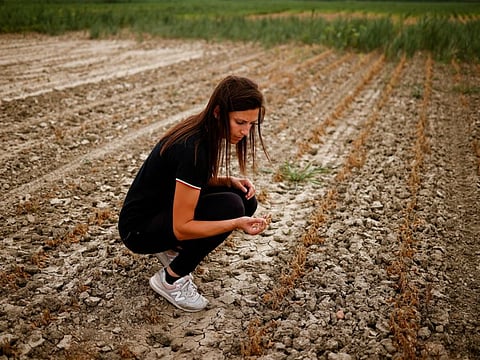Italy declares state of emergency on impact from drought
High temperatures and dry conditions bring water levels in Po river to lowest in 70 years

Italy declared a state of emergency in five northern and central regions devastated by a recent drought, as a severe heat wave takes its toll on agriculture and threatens power supplies.
High temperatures and exceptionally dry conditions have brought water levels in the Po, the country’s largest river, to its lowest in 70 years.
Even amid a historically arid summer across Europe, the situation in the Po valley stands out. Months without rains and an earlier-than-usual halt in flows from melting snow in the western Alps have made large swaths of the river bed visible “- so much so that a German tank from World War II resurfaced recently.
Hydroelectric power, which usually supplies 15% of the country’s needs, is down 50% so far this year, while waters from the Adriatic sea have entered into the Po delta for a record 30.6 kilometres, threatening farming and drinking water supplies. Northern Italian towns are already rationing water.
The extreme conditions have led to an estimated 30% decline in seasonal harvest, including forage, barley, grain and rice in the region, according to agricultural group Coldiretti, exacerbating an already precarious situation for the industry - which the lobby called “strategic” for the national economy - due to the war in Ukraine.
The government led by Prime Minister Mario Draghi will set aside 36.5 million euros ($38 million) in drought relief funds, according to a statement Monday. Draghi rushed home early from a Nato summit last week to chair a meeting on the crisis.
The extreme conditions were underscored over the weekend when a glacial ice shelf collapsed in the northern Italian Alps sheared off amid a record high temperature of 10 degrees Celsius (50 degrees Fahrenheit) at the glacier’s summit.
At least 26 people were caught and at least seven died in the resulting avalanche Sunday, as a chunk of glacier broke loose on top of the Marmolada, the highest peak in the Dolomites range.
Prime Minister Mario Draghi, who travelled to the Alps on Monday, said the tragedy, although having elements of unpredictability, surely depend “on the deterioration of the environment and on the climate situation.”
Sign up for the Daily Briefing
Get the latest news and updates straight to your inbox






